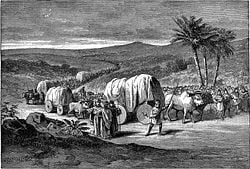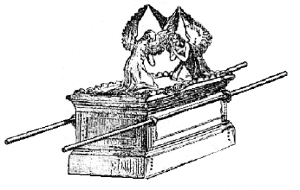Tabernacle (Judaism)
The Tabernacle was a portable central place of worship for the Israelites from the time they left ancient Egypt following the Exodus, until the time its core elements were made part of the final Temple in Jerusalem about the 10th century B.C.E.. It is known in Hebrew as the Mishkan ( משכן "Place of [Divine] dwelling").
The English word "tabernacle" is derived from the Latin word tabernaculum meaning "tent, hut, booth." The word Sanctuary is also used as its name, as well as the phrase "the tent of meeting."
Etymology
The Hebrew word mishkan is related to the word to "dwell," "rest," or "to live in." The Bible often describe God as physically descending in a cloud over the Tabernacle to speak with Moses or otherwise be present among the Israelites. The word mishkan is also relates to the word presence of Shekhina, which rested within this divinely ordained mysterious structure and is also present to pious individual Jews wherever they may be.
The commandments for the Tabernacle's construction are taken from the words in the Book of Exodus when God says to Moses: "They shall make me a sanctuary, and I will dwell among them. You must make the tabernacle (mishkan) and all its furnishings following the plan that I am showing you." (Exodus 25:8-9) Thus the idea is that God wants this structure built so that it may be a "dwelling," for His presence within the Children of Israel following the Exodus.
Description
The Tabernacle was a portable worship facility comprised of a tent draped with colorful curtains. It had a rectangular perimeter fence of fabric, poles and staked cords. This rectangle was carried by the Levites and erected whenever the Israelites camped, sometimes for long periods, oriented to the east. In the center of its enclosure was a rectangular sanctuary draped with goats'-hair curtains, and the roof was made from rams' skins.
Inside, the inner sanctuary was divided into two areas, the Holy Place and the Most Holy Place. These two compartments were separated by a curtain or veil. Entering the first space, one would see three pieces of sacred furniture: a seven-branched oil lampstand on the left (south), a table for 12 loaves of show bread on the right (north), and straight ahead before the dividing curtain (west) was an altar for incense-burning. Beyond this curtain was the cube-shaped inner room known as the Holy of Holies (kodesh hakodashim). This sacred space originally contained a single article, the Ark of the covenant. However, other items were added later, including a vessel containing manna and Aaron's rod, which had miraculously budded as a sign of his divine priesthood.
Contents
The detailed outlines for the Tabernacle and its leaders are enumerated in the Book of Exodus:
- Chapter 25 [1] : Materials needed, the Ark, the table for 12 showbread, the Menorah.
- Chapter 26 [2] : The Tabernacle, the beams, partitions.
- Chapter 27 [3] : The copper altar, the enclosure, oil.
- Chapter 28 [4] : Vestments for the priests, the ephod garment, ring settings, the breastplate, robe, head-plate, tunic, turban, sashes, pants.
- Chapter 29 [5] : Consecration of priests and altar.
- Chapter 30 [6] : Incense altar, washstand, anointing oil, incense.
History
Builders
In chapter 31 [7] the main builder and architects are specified:
- "God spoke to Moses, saying: I have selected Bezalel son of Uri son of Hur, of the tribe of Judah, by name. I have filled him with a divine spirit, with wisdom, understanding and knowledge, and with all types of craftsmanship. He will be able to devise plans as well as work in gold, silver and copper, cut stones to be set, carve wood, and do other work. I have also given him Oholiab son of Achisamakh of the tribe of Dan. I have placed wisdom in the heart of every naturally talented person. They will thus make all that I have ordered, the Communion Tent, the Ark of the Covenant, the ark cover to go on it, all the utensils for the tent, the table and its utensils, the pure menorah and all its utensils, the incense altar, the sacrificial altar and all its utensils, the washstand and its base, the packing cloths, the sacred vestments for Aaron the priest, the vestments that his sons wear to serve, the anointing oil, and the incense for the sanctuary. They will thus do all that I command." (Exodus 31:1-11)
Incorporated into Temple in Jerusalem
When King David conquered Jerusalem and his son King Solomon built the first temple known as Solomon's Temple, all the elements of the tabernacle were incorporated into the newly built permanent temple.
Relationship to the Golden Calf
Some rabbis have commented on the proximity of the narrative of the Tabernacle with that of the episode known as the sin of the Golden Calf which begins in the Book of Exodus 32:1-6 [8]. Maimonides asserts that the Tabernacle and its accoutrements, such as the golden Ark of the Covenant and the golden Menorah were meant as "alternates" to the human weakness and needs for physical idols as seen in the Golden Calf episode. Others scholars, such as Nachmanides disagree and maintain that the Tabernacle's meaning is not tied in with the Golden Calf but instead symbolizes higher mystical lessons that symbolize God's constant closeness to the Children of Israel.
Blueprint for synagogues
Synagogue construction over the last two thousand years has followed the outlines of the original Tabernacle, which was of course also the outline for the temples in Jerusalem until they were destroyed. Every synagogue has at its front an ark, aaron kodesh, containing the Torah scrolls comparable to the Ark of the Covenant which contained the tablets with Ten Commandments. This is the holiest spot in a synagogue equivalent to the Holy of Holies.
There is also usually a constantly lighted lamp, ner tamid, or a candelabrum lighted during services, near this spot similar to the original Menorah. At the center of the synagogue is a large elevated area, known as the bimah where the Torah is read. This is equivalent to the Tabernacle's altars upon which incense and animal sacrifices were offered. On the main holidays the priests, kohanim, gather at the front of the synagogue to bless the congregation as did their priestly ancestors in the Tabernacle from Aaron onwards.
Prayer in the Tabernacle
Twice a day a priest would stand in front of the golden prayer altar and burn fragrant incense. Other procedures were also carried out in the Tabernacle.
Other uses
Within Catholicism, a tabernacle is a cupboard or boxlike receptical for the exclusive reservation of the blessed Sacrament - the bread and wine used during the rite of Holy Communion. In the Early Christian times such tabernacles containing the sacred species were kept within private houses where Christians met for church, for fear of possible persecution.
The Tabernacle is also seen in some Christian circles as representing Jesus Christ.
External links
- [An exact, full-scale replica of the Tabernacle is under construction!
- An excellent study of the Tabernacle in everyday English
- The offerings of the Tabernacle
- The Tabernacle and its contents, in Hebrew, with many diagrams
- Jewish Encyclopedia article
- Tabernacle model Christian Perspective
- Tabernacle Model and Free Tabernacle Lessons
- Tabernacle from a Christian Perspective - Thomas Newberry editor of the Newberry Reference Bible
- The Tabernacle model at Glencaírn museum
- "Tabernacle Shadows"
Credits
New World Encyclopedia writers and editors rewrote and completed the Wikipedia article in accordance with New World Encyclopedia standards. This article abides by terms of the Creative Commons CC-by-sa 3.0 License (CC-by-sa), which may be used and disseminated with proper attribution. Credit is due under the terms of this license that can reference both the New World Encyclopedia contributors and the selfless volunteer contributors of the Wikimedia Foundation. To cite this article click here for a list of acceptable citing formats.The history of earlier contributions by wikipedians is accessible to researchers here:
The history of this article since it was imported to New World Encyclopedia:
Note: Some restrictions may apply to use of individual images which are separately licensed.


